How To Make A Frog Or Toad Hideout: Create a Safe Backyard Shelter for Amphibians
Creating a frog or toad hideout in your backyard is easy and rewarding. Not only will you provide a safe space for these amphibians, but you’ll also help control pests naturally.
To build a simple frog or toad house, find a small container or box, fill it with damp soil, and place it in a shady spot near a water source.
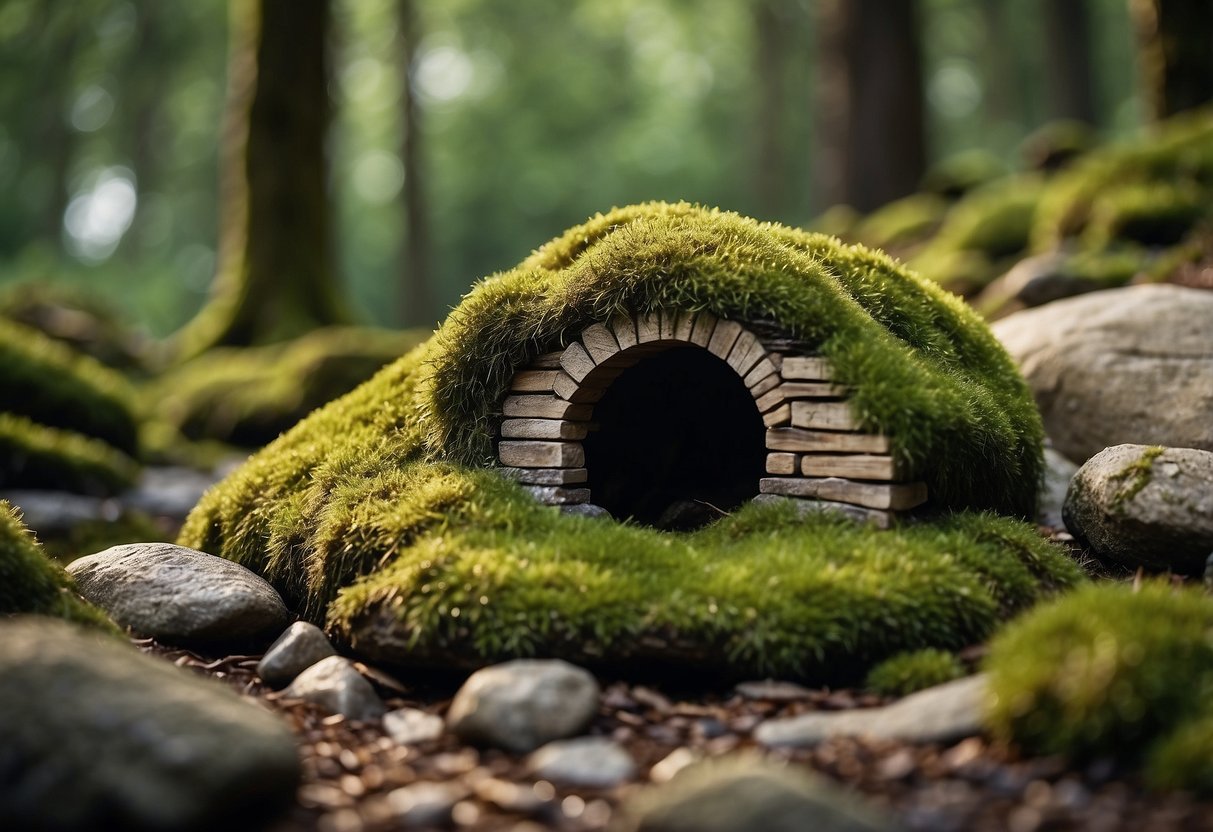
You can enhance the hideout by adding vegetation, rocks, and logs to create hiding spots.
Camouflaging the hideout with soil and plants will make it more appealing and help protect the frogs and toads from predators.
Placing the hideout near dense, low vegetation will maintain moisture and provide necessary cover.
Ensuring there’s a water source nearby, like a shallow dish, will make your frog or toad hideout more attractive.
By following these simple steps, you can create a welcoming environment for these helpful amphibians in your backyard.
Key Takeaways
- Build a simple frog or toad house with a container and damp soil.
- Enhance the hideout with rocks, logs, and vegetation.
- Place the hideout near a water source and low vegetation for best results.
Understanding Frogs and Toads
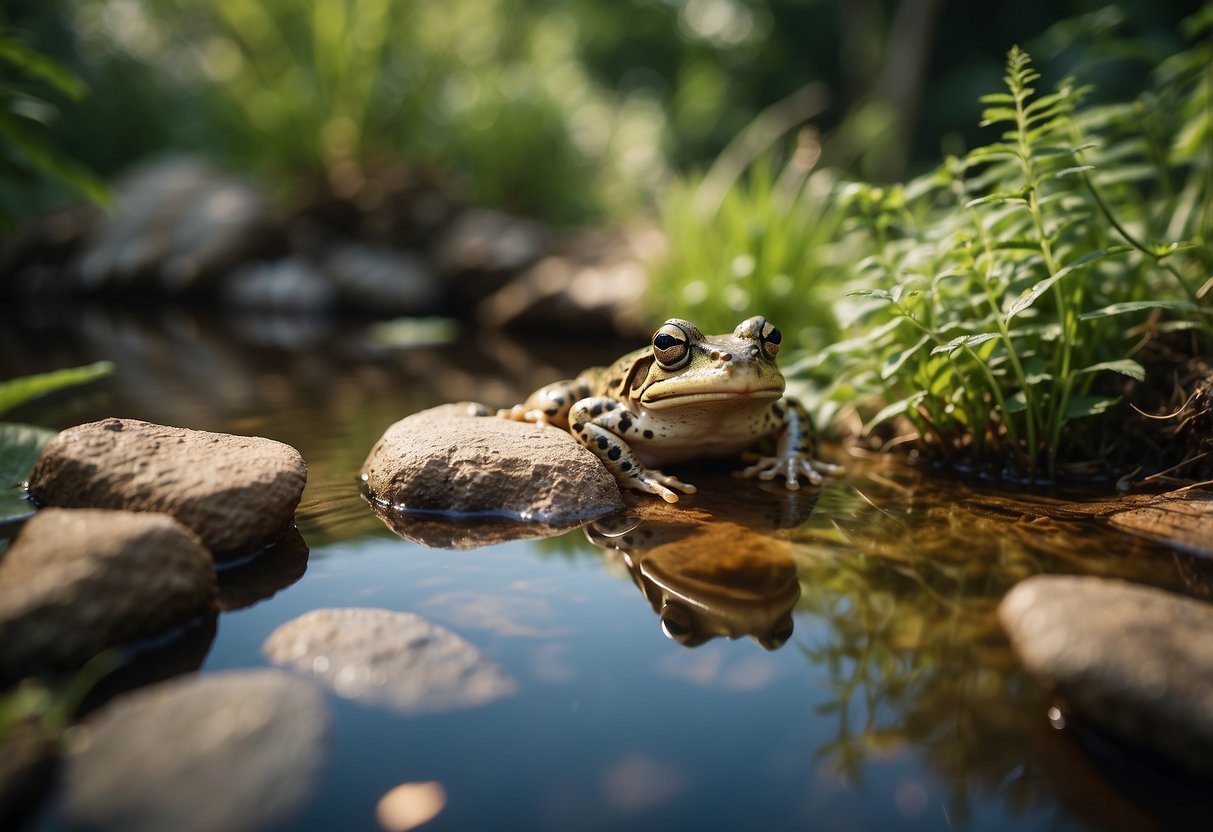
Frogs and toads each have specific habitat requirements and offer unique benefits when present in your garden. Knowing their preferences can help you create a suitable hideout.
Habitat Preferences
Frogs typically need moist environments to thrive. They are often found near water sources like ponds, streams, and marshes.
Frogs prefer spots with ample cover such as plants, rocks, and logs to hide from predators.
Toads, on the other hand, can live in drier areas. They are often found in gardens and forest floors where they can burrow into loose soil.
Toads also seek out shaded places and are more adaptable to varying moisture levels. Ensuring a mix of moist and dry hideaways will cater to both amphibians.
Benefits of Having Frogs and Toads in Your Garden
Frogs and toads are great for controlling pests. They eat insects like mosquitoes, flies, and beetles, helping to maintain a balanced ecosystem in your garden. This natural pest control can reduce the need for chemical pesticides.
Additionally, having these amphibians around can indicate a healthy environment.
Frogs and toads are sensitive to pollutants, so their presence suggests your garden has clean air, water, and soil.
They also contribute to soil health through their digging and burrowing activities, which can aerate the ground and improve plant growth.
Encouraging frogs and toads to live in your garden not only promotes biodiversity but also helps in creating a more sustainable and thriving outdoor space.
Assessing Your Backyard
Before creating a frog or toad hideout, you’ll need to evaluate your backyard to find the best spot and understand any potential dangers. This will ensure a safe and welcoming environment for these amphibians.
Selecting the Right Location
Choosing the right spot is crucial for the success of your frog or toad hideout. Look for an area that gets a mix of sunlight and shade. Frogs and toads need a balance of both to regulate their body temperature.
Make sure the location is near a water source. A small pond or even a shallow dish of water can be very attractive to amphibians.
The water source should be clean and free of chemicals or pollutants, as frogs and toads are sensitive to contaminants.
Consider the types of plants in the area. Native plants are the best choice because they attract insects that frogs and toads like to eat.
Plants also provide hiding spots and shelter from predators.
Identifying Potential Hazards
It’s important to identify and mitigate any hazards in your backyard to keep the frogs and toads safe.
Check for common predators such as cats, dogs, and birds, which can pose a threat. Keeping pets indoors or creating barriers can help protect the amphibians.
Avoid using chemical pesticides and fertilizers. These substances are harmful to frogs and toads, as they can be absorbed through their skin. Opt for natural pest control methods instead.
Look out for any sharp objects or debris that could injure the amphibians. Clean up the area to ensure it’s free of hazards.
Additionally, make sure there are no deep holes or large gaps where tadpoles or young frogs might get trapped.
Designing the Hideout
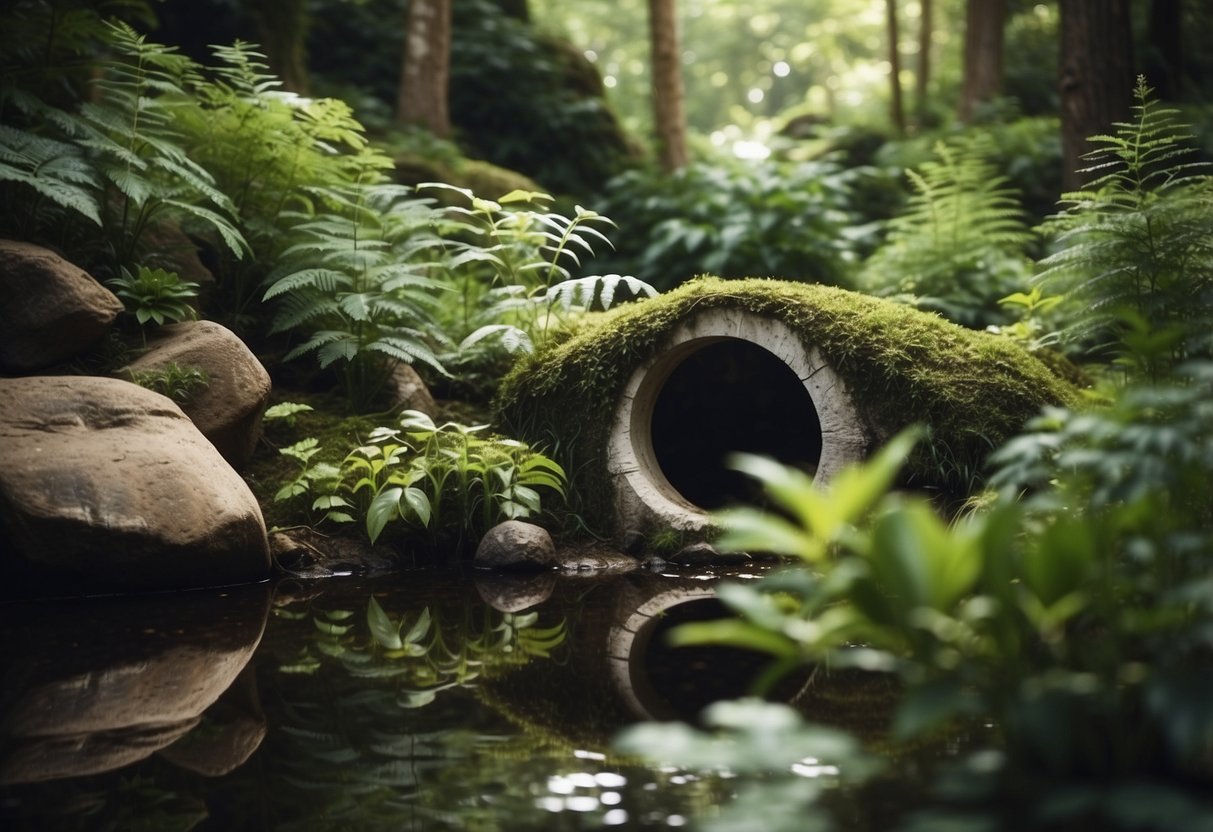
When planning a frog or toad hideout in your backyard, consider both the choice of materials and how to structure the hideout. Each element is important to create a comfortable and inviting space for these amphibians.
Choosing Materials
You’ll need a clay pot, soil, and rocks. Clay pots are ideal because they retain moisture well, keeping the interior cool and damp.
Choose a pot that’s at least 6 inches in diameter for a good size hideout.
Additionally, gather natural materials like soil and small rocks to provide a solid foundation. The rocks will also help with drainage and stability.
You can also add aquatic plants if you plan to place your hideout near water. These plants provide extra cover and keep the environment suitable for frogs and toads.
The materials should blend with the natural surroundings to protect the hideout from predators and environmental elements.
Structural Considerations
First, place the clay pot on its side to form a cave-like structure. Make sure the opening is big enough for frogs or toads to enter easily but not so large that it loses the cozy, secure feeling.
To further stabilize the hideout, partially bury the pot in soil. This helps keep the pot in place and provides a solid floor for burrowing.
Ensure there is adequate airflow by leaving a small gap or hole in the pot.
Position the hideout near a water source but in a shaded area to keep it cool. Adding rocks and plants around the hideout will provide camouflage and extra security.
Finally, ensure the hideout is accessible yet hidden from direct sunlight, which can quickly dry it out.
Building the Hideout
Creating a frog or toad hideout in your backyard involves simple materials and careful placement to ensure the safety and comfort of these amphibians. Follow these steps to make a cozy home for your garden guests.
Step-by-Step Construction
To start, you will need a clay pot, a drill, and some garden tools.
First, find a suitable clay pot. Lay the pot on its side. Then, drill a door into the pot. The door should be about one-quarter of the pot’s size. This helps frogs and toads easily enter and exit.
Drill 1 mm deep holes into the pot at a 45° angle. Wetting the pot helps the drill make clean holes.
Place the pot in a shaded spot with ample cover, such as tall grass or shrubs, to provide protection from predators.
Lastly, you can add some leaves or small twigs inside the pot to make it more inviting. This mimics the natural environment that amphibians prefer. A bit of moisture is also beneficial, so place the pot near a water source if possible.
Ensuring Stability
Ensuring the stability of your hideout is crucial for its longevity and effectiveness.
Begin by selecting a stable, flat surface for placing your pot. If the ground is uneven or sloped, you may need to level it by adding or removing soil.
Once the ground is prepared, partially bury the pot’s bottom edge. This keeps the hideout stable and less likely to tip over. Make sure the entrance stays clear from debris or soil.
Additionally, surround the hideout with rocks or small stones to further secure it. This will also provide a natural look.
Regularly check and ensure the pot remains stable. Weather conditions or curious garden animals might shift it over time.
Hideout Maintenance
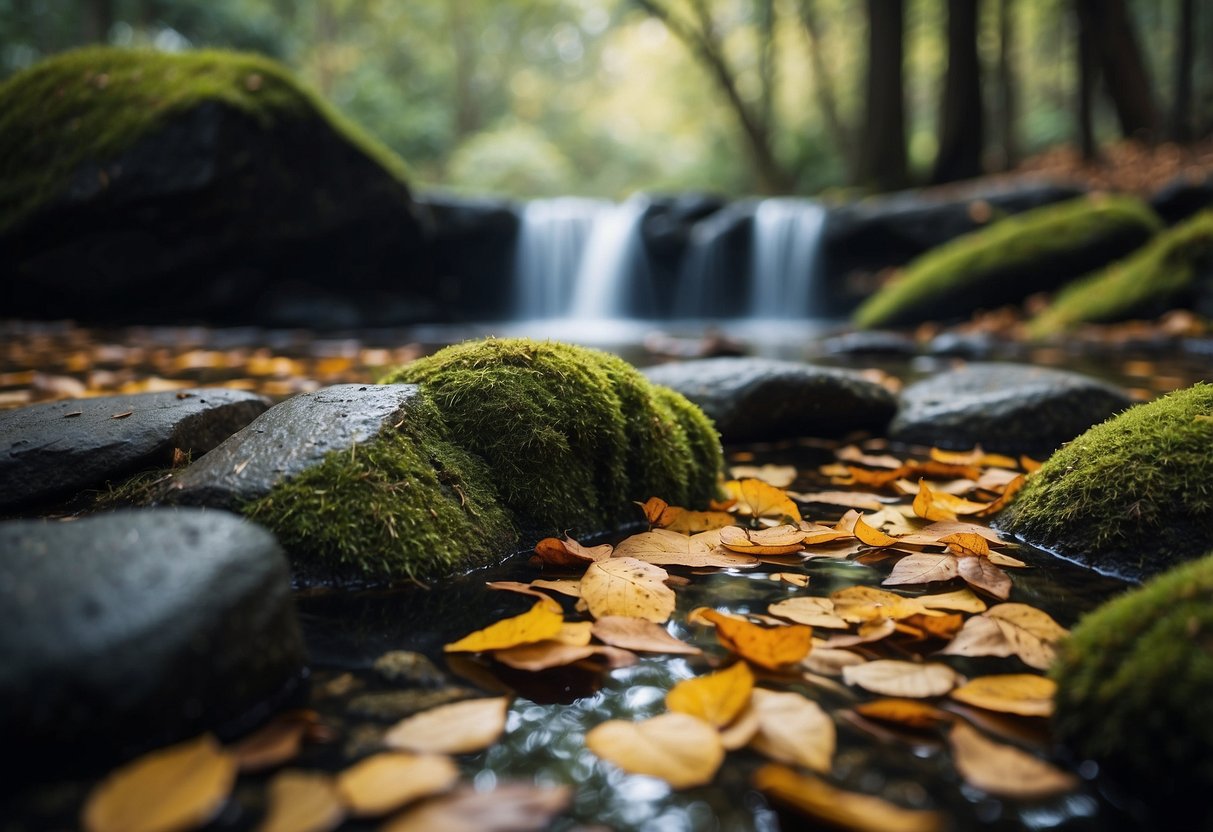
Proper maintenance of your frog or toad hideout ensures a safe and healthy environment for these amphibians. This involves performing regular checks and making seasonal adjustments to adapt to changing conditions.
Routine Checks
Routine checks are essential to maintain a healthy habitat.
Inspect the hideout every few weeks. Look for debris and remove it to keep the area clean. Check for signs of pests or predators and take action if needed.
Ensure that water sources like ponds or containers are clean and topped up. If the water is stagnant, it can attract mosquitoes. Aerate the water or use a small fountain to keep it moving.
Examine the plants around the hideout. Trim any overgrowth that may block access.
Native plants might need less attention, but they should still be monitored. Watch for signs of disease or damage and replace plants if necessary.
Seasonal Adjustments
Adjust the habitat as the seasons change.
In spring, focus on planting new vegetation and adding shelter materials like logs and rocks. Spring rains can fill ponds naturally, reducing the need for manual water additions.
Summer requires more frequent watering, especially during dry periods. Ensure that there is enough shade to prevent overheating. Add more plants or temporary shade structures if needed.
In fall, clear fallen leaves from the hideout. Leaves can provide insulation but may also host pests. Maintain a balance by keeping some leaves while removing excess.
Winter preparations are crucial.
If you live in a colder region, consider adding extra insulation with leaves and mulch. Ensure that water sources are not frozen by using heaters or regular manual defrosting.
Enhancing the Habitat
To make a welcoming spot for frogs and toads, you need to focus on water features, the right plants, and food sources. These three elements are vital for creating a thriving environment.
Adding Water Features
Frogs and toads need access to water to survive. A small pond or even a birdbath placed at ground level can attract these amphibians.
Ensure the water is clean and avoid using chemicals that could harm them.
You can also add rocks and logs around the water source for hiding spots.
If space allows, installing a pond with gentle slopes helps amphibians easily get in and out. Natural vegetation around the water will keep the environment cool and moist.
Planting Vegetation
Native plants are essential as they attract insects and provide shelter.
Choose plants of various heights to create a natural and layered habitat. Shrubs, grasses, and ground covers work well.
Plants like ferns and hostas offer moist, shady areas, perfect for amphibians.
Aim to create a dense, diverse garden with plenty of hiding spots.
Avoid using pesticides and fertilizers that can harm the frogs and toads and their insect food sources.
Providing Food Sources
Frogs and toads eat a variety of insects and other small creatures. Providing a habitat that attracts bugs ensures a steady food supply.
Planting native vegetation is key, as it brings in ants, beetles, and other insects.
Avoid using chemicals that could kill off their food.
Instead, encourage natural insect populations by keeping the habitat diverse.
Compost piles or leaf litter can also serve as hunting grounds for these amphibians.
Monitoring Your Backyard Ecosystem
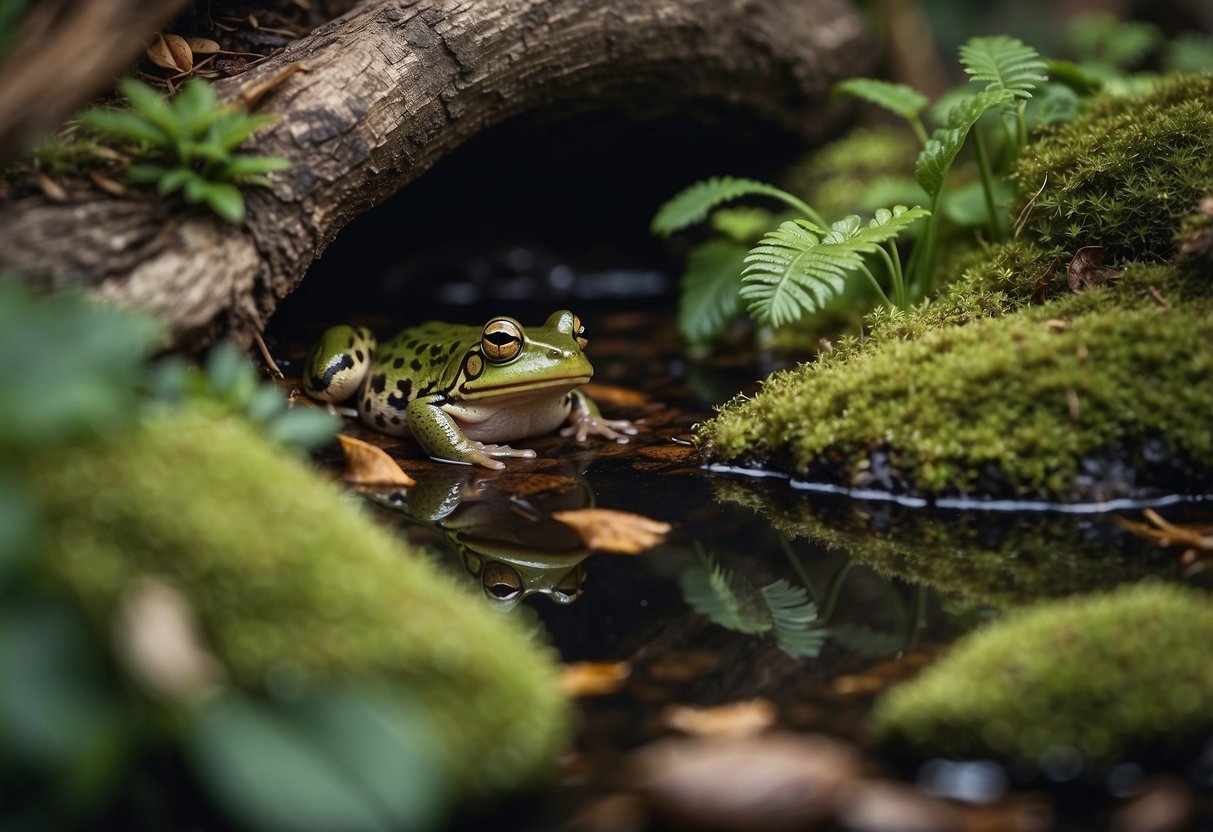
Keeping a close eye on changes in your backyard and participating in community science projects can significantly enhance your frog or toad habitat.
Noticing Changes
Observing changes in your backyard is crucial.
Pay attention to the number of frogs or toads you see over time.
Note their behaviors, such as when they are most active, their calls, and their breeding patterns.
Examine the health of your plants and water sources, as these factors affect the amphibians’ habitat.
Check for the presence of predators and pests that might disturb the ecosystem.
Document these observations in a journal or use a simple app on your phone to track data.
Regular monitoring helps you quickly spot problems, like a decline in frog populations, so you can take action to correct it.
Community Science Contributions
Community science projects allow you to share your observations with scientists.
You can join initiatives that track frog and toad populations, such as FrogWatch USA or similar programs.
These organizations provide tools to help you accurately record and submit data on amphibian sightings and calls.
By contributing, you not only help scientists understand environmental trends, but you also learn more about your local ecosystem.
Participation often includes access to resources and support from experts.
This collaboration strengthens your efforts to maintain a thriving frog or toad habitat in your backyard.
Stay engaged and communicate with other backyard naturalists through forums or local groups.
Sharing your experiences and learning from others can improve your monitoring techniques and enhance your understanding of the ecosystem.
Frequently Asked Questions
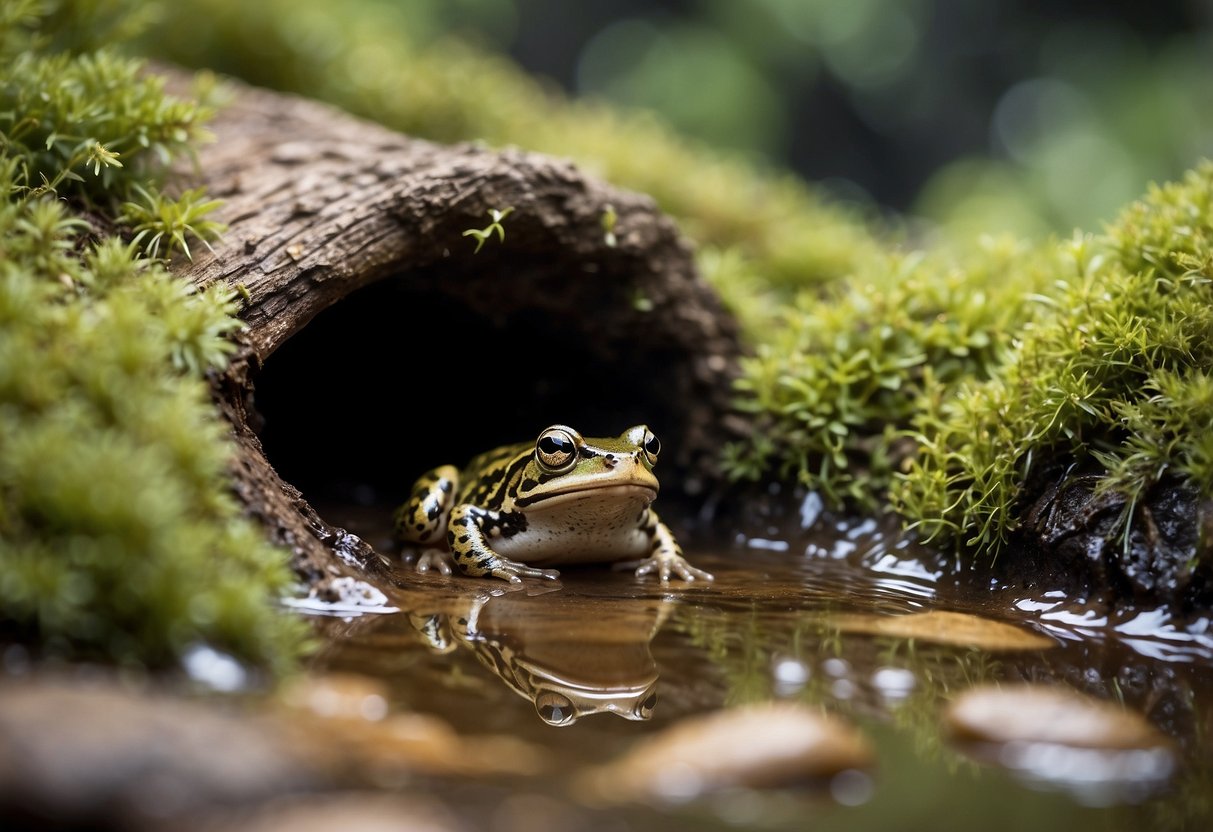
Creating a frog or toad hideout involves using natural materials, designing effective shelters, and maintaining the right environmental conditions. Here, we address common questions related to these aspects.
What materials are needed to create a frog or toad hideout in the backyard?
Use natural materials like rocks, logs, and clay pots. Avoid using chemicals, pesticides, and fertilizers.
Fresh water is essential, so incorporate a small pond or a container filled with de-chlorinated water. Dense vegetation can provide shelter and attract insects.
Can you suggest some effective designs for a homemade frog or toad house?
Create shelters by stacking terracotta pots or bricks. Ensure there are gaps for entry and exit.
Another option is a Toad Abode, which can be crafted from broken clay pots and should not have a bottom, allowing frogs to dig into the earth underneath.
What environmental conditions are critical for maintaining a healthy frog or toad habitat outdoors?
A healthy habitat requires fresh water, abundant vegetation, and safe hiding spots.
De-chlorinate the water before adding it to the pond. Plant native vegetation to attract insects, which serve as food.
Avoid using harmful chemicals in the area.
What are the best plants to include in a backyard to attract and sustain frogs and toads?
Select native plants to attract local insects. Examples include ferns, water lilies, and marsh marigolds.
These plants not only provide food for frogs and toads but also offer shelter and hiding spots from predators.
How can I ensure the safety and protection of a frog or toad habitat from predators?
To protect the habitat, use dense plant cover and hiding spots like rocks and logs.
Install small fences around the pond to keep out larger animals. Avoid bright lights at night, as they can attract predators to the area.
Which features are important to include in a backyard habitat to support the lifecycle of frogs and toads?
Ensure the habitat has water sources for breeding, and moist, shaded areas for resting.
Include plants that provide food and shelter. Proper hiding spots like logs and rocks are necessary for safety.
Maintaining these features supports the entire lifecycle from tadpole to adulthood.
